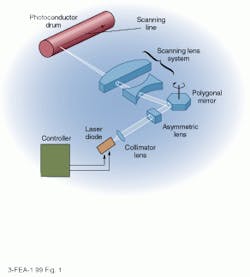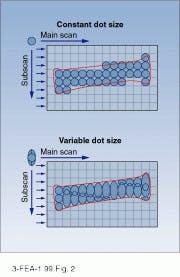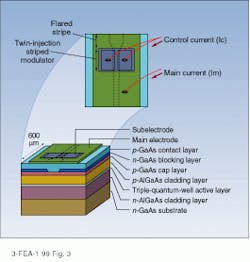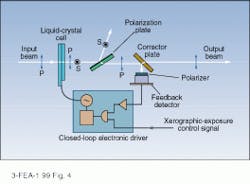Printers, which have become standard computer peripherals, are among the most widespread applications for lasers. Although the technology is fairly mature, users continue to thirst for more speed and higher resolution—which now approaches the limits of what the eye can detect. These requirements are driving ongoing innovation in laser optics and controls.
At the same time, laser image recording is infiltrating new areas. Physicians, increasingly reliant on diagnostic imagers, need laser image recorders to transfer the output accurately onto conventional film that is compatible with the light boxes long used to view x-ray images. Image recording based on laser holography also is beginning to inch out of its niche market into more widespread use.
Basics of laser printing
A laser printer works by exposing a photoconducting material to laser light. For each pixel in the electronic image, the system produces a single dot of laser-exposed photoconductor. In this area, it picks up toner and transfers it to the output paper. The laser scans across the image, line by line, using a polygonal mirror rotating at high speed (see Fig. 1).
While high-end laser printers now produce some 1200 dots per inch (dpi), some applications may require even higher resolution to reduce jaggedness in oblique lines and allow quality image enlargement during a reproduction process. Each time resolution doubles, however, the number of dots increases fourfold. To avoid diffraction effects, laser-beam size must increase as the focused-spot size decreases. This increases the size of the mirror facets. To maintain printing speed, mirrors must thus rotate faster to produce more scan lines per second.
Greater processing rates also increase demands on the modulation of the laser diode necessary to generate crisply separated spots. For example, a system generating two pages per second at 1200 dpi requires 200,000 scans per minute and a laser modulation frequency of 400 MHz. Such a high frequency is extremely difficult to achieve in practice, and, as a result, higher resolution tends to lead to lower printing speeds.
One way around the resolution-speed trade-off is to smooth the image formed using laser printers with variable spot sizes. With constant spot sizes, when an oblique line is drawn, as in a printed letter, the line of dots often forms a staircase pattern (see Fig. 2). Varying the spot size across the span will produce a much smoother outline without increasing the number of dots, scan rate, or modulation frequency.Research at Hitachi Central Research Laboratory (Tokyo, Japan) illustrates feasibility of this approach.1 Project results show that changing the near-field spot size of the laser diode translates to variable spot size at the photoconductor. This, in turn, requires that the injection current be varied. The laser diode has two current-injection regions, one of which is controlled by the size-modulating current (see Fig. 3). The modulator current affects the width of the waveguide within the diode because it changes the refractive index of one side of the guide. This allows a 2:1 variation in spot size, with considerable smoothing of the printed line. As a result, the Japanese researchers achieved smoothness that normally requires 1200 dpi at only 600 dpi, which cut the modulation frequency by a factor of four.
Making medical hard copy
The laser printer is not the only method of laser image recording. In medical applications, laser printing directly on silver halide photographic film is the standard way to prepare hard copies of digital images.3 Today, physicians and surgeons have access to a dozen computer-based diagnostic imaging technologies, such as computed tomography, positron emission tomography, magnetic resonance imaging, and digital angiography.
While the results of these modalities can be viewed on CRTs, physicians have become used to viewing films in light boxes, as they do with conventional x-rays. This requires laser printers to transfer the images to the film. Laser medical-image recorders thus work on the same principles as conventional laser printers, except that they generally operate within more stringent exposure tolerances.
Also gaining popularity is computer-to-plate (CTP) technology for commercial printing. Conventional plate-making processes use film as an intermediate step and produce the plate by contact exposure with an ultraviolet source. In CTp technology, a laser transfers the image directly from computer to plate, either ablating thin layers of material or thermally cross-linking polymers, which are later chemically processed to remove nonimaged material.
The exposure threshold for ablation is 100 mJ/cm2. The threshold for thermal cross-linking is roughly twice as high. Materials are optimized for either 830-nm laser diodes or 1064-nm diode-pumped solid-state lasers. In these systems, more designers are using multiple-beam systems to gain speed. This is particularly true of high-end plate-making equipment, but printers with diode arrays are also coming on-line in lower-end devices.
Looking at holography
A less common method of laser image recording is holography, which remains fairly confined in its applications three decades after it was first developed. However, its increasing use as a security device to reduce counterfeiting of credit cards has propelled it beyond the novelty and laboratory applications that were long the norm. Currently, the main developments are in new materials for recording holographic images.4
Holograms are formed when laser light reflecting off an object interfaces with light received directly from the laser. Typical surface holograms are recorded initially on photoresist materials sensitive to short wavelengths, such as argon-ion laser emission at 459 nm or helium-cadmium at 325 nm. High optical quality is possible if the spacing of the hologram fringes is comparable to the wavelength of the illuminating light. However, such holograms require longer exposures and are limited to short wavelengths.
For the manufacture of embossed holograms a metallic layer such as nickel is plated over the photoresist. This is then removed and subsequently used to emboss the holographic pattern into thermoplastic films.
For volume holograms, a wide variety of photopolymers is now available as recording material, and new photopolymers are being announced nearly every year. These films start out as monomers, which are liquids coated onto a polymeric binder substrate for support. When exposed to light during hologram formation, cross-linking polymerization proceeds faster in the bright fringes than in the dark ones and depletes these areas of monomers. The small monomer molecules diffuse into the depleted regions. When the film is again exposed from the reference laser beam alone, or another source, the remaining monomers polymerize with a distribution that corresponds to the intensity distribution of the interference pattern.
In photopolymers developed by E. I. DuPont (Wilmington, DE), the leading producer, a photosensitizing die is added to extend the wavelength range sensitivity of the film. The dye intersects with an initiator to set polymerization in motion. The films also include plasticizers to promote monomer diffusion.
The recent development of shorter-wavelength laser diodes facilitates hologram generation, because diode lasers are far more compact than the gas lasers previously used. As a result, holograms can be made outside a laboratory for purposes such as the recording of objects in archaeological digs or museums.
REFERENCES
1. S. Nakatsuka et al., Appl. Opt. 38, 5876 (Aug. 1997).
2. J. R. Andrews and J.-M. Guerin, SPIE 2383, 345 (Jan.1995).
3. H. Blume and E. Muka, SPIE 2413, 206 (Feb. 1995).
4. W. S. Colburn, J. Imag. Sci. and Tech. 41, 443 (Sept. 1997).
Eric J. Lerner | Contributing Editor, Laser Focus World
Eric J. Lerner is a contributing editor for Laser Focus World.



